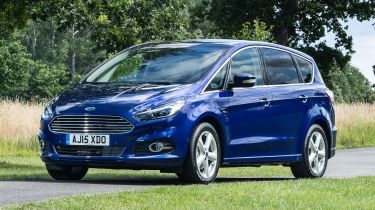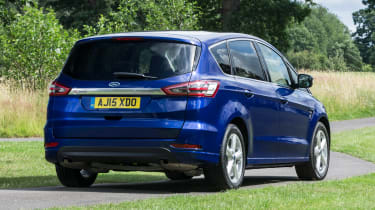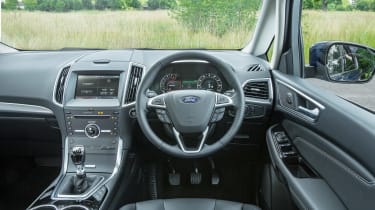Used Ford S-MAX review
A full used buyer’s guide on the Ford S-MAX covering the S-MAX Mk2 (2015-date)
Verdict
The Ford S-MAX is a bit of a contradiction, because while it’s as big as a full-sized people carrier, it doesn’t offer the ultimate in carrying capacity thanks to its lower roof line. As a result, you should think of it as a seven-seat estate, with the flexibility of an MPV if you need to carry a couple of extra people – as long as they’re children. In typical Ford fashion, the S-MAX offers great value, an enjoyable driving experience and some impressive engines that are both frugal and perky. Some owners reckon Ford’s build quality can’t compete with that of premium brands in places, but that shouldn’t put you off because this stylish family car is a tempting proposition as a used buy.
If you had to pick two motoring opposites, it would probably be the people carrier and the sports car. Trying to combine the best bits of two such diverse types of car would be a thankless task, but that’s what Ford did with the S-MAX in 2006.
As big as a Galaxy but lower and sleeker, the S-MAX proved that just because you needed a seriously practical carry-all, you didn’t have to sacrifice driving pleasure.
The original sporty S-MAX proved a smash hit for Ford, so when an all-new version was launched nine years later, hopes were high for similar success. By then MPVs had fallen out of favour, but if you’re in the market for an ultra-practical estate car, an S-MAX could be a very tempting option.
Used - available now

2022 Ford
S-Max
22,587 milesAutomaticPetrol2.5L
Cash £26,015
2019 Ford
S-Max
63,520 milesManualDiesel2.0L
Cash £16,600
2012 Ford
S-Max
64,977 milesManualDiesel2.0L
Cash £6,495
2022 Ford
S-Max
42,721 milesAutomaticDiesel2.0L
Cash £20,998Models covered
- Ford S-MAX Mk2 (2015-date) – Second-generation people carrier delivers plenty of space and tech for the money.
History
The S-MAX Mk2 arrived in summer 2015 with 158bhp 1.5 or 237bhp 2.0 EcoBoost (SCTi) petrol engines, or a 2.0 Duratorq diesel with 119bhp, 148bhp, 177bhp or 207bhp. There were three trim levels (Zetec, Titanium, Titanium Sport) and while most cars had front-wheel drive, four-wheel-drive editions were available (2.0 TDCi 150 Titanium and 2.0 TDCi 180 Titanium Sport, the latter in Powershift auto form only).
Range-topping Vignale trim joined the line-up in summer 2016, then in September 2018 a range update saw extra safety tech introduced, the Duratorq diesels replaced by 2.0 EcoBlue units in 119bhp, 148bhp and 187bhp forms, and an eight-speed automatic transmission introduced. An exterior design refresh was introduced in November 2019, along with improved connectivity and the option of 18-way adjustable front seats.
Which one should I buy?
You’re unlikely to find an entry-level S-MAX; most buyers chose Titanium trim and a diesel with at least 148bhp. As a result, whatever you track down should be a good bet in terms of performance, economy and comfort/safety features. Besides, even the cheapest Zetec trim comes packed with equipment, including 17-inch alloys, an eight-inch touchscreen display, front and rear parking sensors, DAB radio, sports seats, electrically folding door mirrors and keyless go.
Titanium adds navigation, privacy glass, automatic lights and wipers plus extra safety systems, while the Titanium Sport (replaced by ST-Line in summer 2018) gets 18-inch wheels, heated front seats, sports suspension and revised body styling.
The Vignale comes with 19-inch wheels, a rear camera, powered tailgate, heated steering wheel, cashmere interior trim plus an upgraded Sony multimedia system.
Alternatives to the Ford S-MAX
The obvious S-MAX alternative is the Ford Galaxy, which offers an even roomier cabin and can easily carry seven adults. As the UK’s best-selling people carrier, there’s ready availability and prices are keen. Two alternatives which are closely related are the SEAT Alhambra and Volkswagen Sharan, which impress with spacious cabins, excellent build quality, sliding side doors and a refined car-like driving experience.
The Citroen Grand C4 SpaceTourer (previously Grand C4 Picasso) comes with efficient diesel engines, lots of kit and a high-quality interior, but as with the S-MAX, third-row space is tight. If you want a great drive, don’t overlook the BMW 2 Series Gran Tourer, which is versatile and well made but more expensive than the S-MAX.
What to look for
Screenwash
The S-MAX’s windscreen washer jets can’t be adjusted. If they’re aimed incorrectly they may have to be replaced.
Auto box
The Powershift transmission must be scrupulously maintained with the correct oil in order to avoid costly problems developing.
Plastics
A number of owners reckon that some of the interior materials Ford has used aren’t tough enough for use in a family car, so check for damage.
Extras
Key options worth having include the panoramic glass roof, effective adaptive LED headlights, and useful front and rear parking cameras.
Interior
The key reason why many people buy an S-MAX is for its spacious, comfortable and versatile cabin. They’re unlikely to be disappointed, and the high seating position that gives excellent forward visibility will appeal to lots of potential buyers.
Head and legroom are plentiful in the first two rows, but the pair of seats in the boot are only really suitable for children. The third row folds flat with the pull of a strap, while the middle row is folded via buttons set into the side of the boot.
You get anywhere between 285 litres and 2,020 litres of boot space, but there aren’t many options when it comes to strapping smaller items in place.
Running costs
Routine S-MAX maintenance takes place every 12 months or 12,500 miles – whichever comes first. There’s surprisingly little fluctuation in service costs – especially where the petrol units are concerned.
For the first 10 services, prices range from £203-£278 for the petrol engines, while diesel maintenance varies a bit more, at £213-£364. The latter cost is for the sixth service, which is the biggest of all; the third and ninth services are £332, whereas all the others are closer to the £220 mark. All S-MAX engines are fitted with a cambelt that costs £399 to be replaced (£499 if the water pump is also changed); the work has to be done at the 10-year mark, or when the car hits 144,000 miles.
Recalls
The Ford S-MAX Mk2 has been recalled five times so far, with the first campaign launched in June 2016. This was because the headlights could switch themselves off on some cars that were built up to February 2016.
Overheating diesel engines leading to the sump cracking were the reason for the second recall, which was launched in March 2018. Four months later, faulty clutches led to the third recall being issued. This was followed by the fourth being launched in November 2018 because of faulty air-conditioning compressors.
The faulty clutches that led to the third recall focused on the petrol-engined S-MAX, and the same models were recalled again in February 2019. The issue surrounded the clutch pressure plate, which was known to be prone to fracturing and therefore needed replacing.
Driver Power owner satisfaction
The S-MAX has never appeared in our new or used Driver Power surveys. Overall, Ford came 24th in our 2020 brands survey, a place lower than in 2019; the only top-10 placing was for its infotainment systems. Owners give the S-MAX an average of 4.4 out of five on carbuyer.co.uk, loving the value, space and handling, while SYNC 3 infotainment gets the thumbs up, but the earlier SYNC 2 system isn’t so popular.









